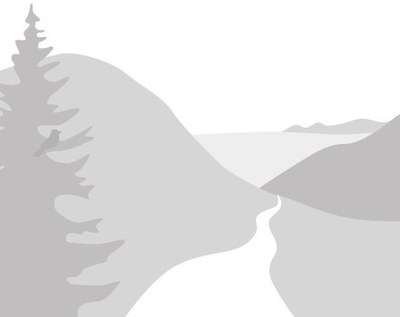
Trip Report
Intermediate Ice Climb - Chair Peak/Northeast Buttress (winter)
A full-value winter experience and a successful summit on a good day, with multiple other groups on the route.
- Sun, Mar 8, 2020
- Intermediate Alpine Climb - Chair Peak/Northeast Buttress (winter)
- Chair Peak/Northeast Buttress (winter)
- Climbing
- Successful
-

- Snow and ice on road
-
Approach and descent currently requires snowshoes. The snow has a hard crust on it, but boots immediately break through that thin surface crust and result in knee-deep postholing. Snowshoes, on the other hand, mostly don't break through the crust, which makes walking in snowshoes a bit hard on the ankles. Descent is a knee-buster, with the steep snow too hard to comfortably plunge-step in snowshoes in most places.
Some avy debris visible on approach, and evidence of wind loading lower at the ridge that extends below the base of the climb. A climber who ventured too close to that area has heard a whoomph. We carefully avoided that section.
Generous snow ramp at the base of the climb, goes all the way to the slings. The left side (direct) has good ice for anchors that took 16cm (but not 22cm) screws. The right side (S-shaped ice gulley) posed a challenge to one party that tried to explore it. They eventually made it to the summit, but we heard them struggle for quite a while to build a belay anchor at the base of the first pitch. We went for the direct ascent on the left-side.
Snow on the second and third pitch sort of allows you to make a wimpy snowball. Good enough to have a modicum of confidence in a deadman picket, and in selected spots, even vertical mid-clip. Not a perfect styrofoam, but nevertheless, great for sinking in tools and frontpointing.
The ice step was more or less vertical, but just barely more than a body length. Reasonably good ice tool purchase made it easy to negotiate. Above the ice step, however, the ice was too thin even for a stubby. The top of the ice step pitch was a runout, with one vertical mid-clip picket hammered into a harder patch of snow. Carrying a shovel on that pitch has proven essential to being able to build a deadman picket anchor at the end of this pitch, which uncomfortably terminates at a random point of a steep section of a snow slope.
The rap anchor is easily accessible, only a few feet above the snow.
The original plan was to climb the Reid Headwall at Mt Hood, but -30C with windchill at the summit wasn't everyone's idea of fun. Switched to Lane Peak as a backup after that, but we lost the critical mass of 3 climbers to do it as a two-day trip. I didn't feel confident in our ability to pull it off in a day between the gate opening and closing, and didn't want to abuse the emergency gate opening option by deliberately planning on returning late.
Chair Peak started as our backup for a backup, but the forecast improved, and by the time we ran out of primary options, it started to look pretty solid. A last-resort posting on a social networking site turned out to be an instant hit. Everyone loves Chair Peak! Within an hour, we had 5 climbers stoked for the climb, committed, and read to deploy.
My initial plan was to meet 4:30am, hit the trail by 5am, be at the base of the climb by 8am, back to the flats before sunset, and back to cars 7-9pm. A bit on the early side of the start time range in part out of the concern about other parties competing for the route on what was beginning to look like a day with pretty good conditions. I was estimating ~14-16 hours car-to-car. We managed to beat these estimates by half an hour.
Due to some snafus with daylight savings (2:30am never happened), we got a bit of a delayed start, but we still hit the trail 5:20am. We were the first party on the approach (but spoiler alert: not on the route; more on this below).
We used snowshoes on approach. The snow was packed on the trail, but recent trip reports warned about post-holing, and besides, I like having heel raisers with my stiff 4-season mountaineering boots. We made it through the flats to Source Lake in about 50 minutes.
After that, meandering through the snow slopes slowed us down. In the lower part of the approach above the Source Lake, the snow surface was hard and not so comfortable to switchback in snowshoes, but we were still able to move reasonably efficiently. As it started to get bright, we were greeted with beautiful views.
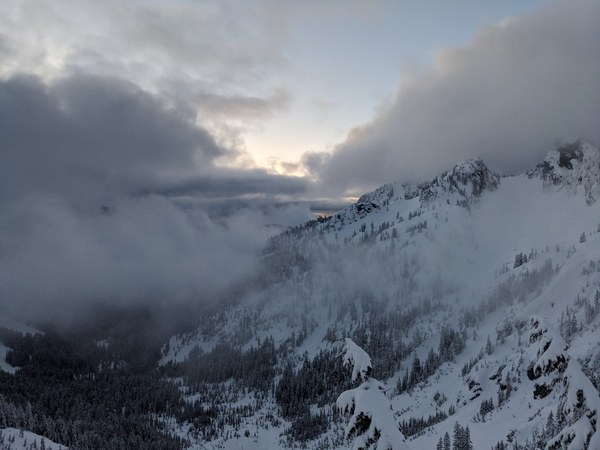
Great views made for happy climbers, brimming with anticipation like a puppy staring at a tasty slice of bologna with eyes as round as dinner plates. So much outdoor bologna all around!
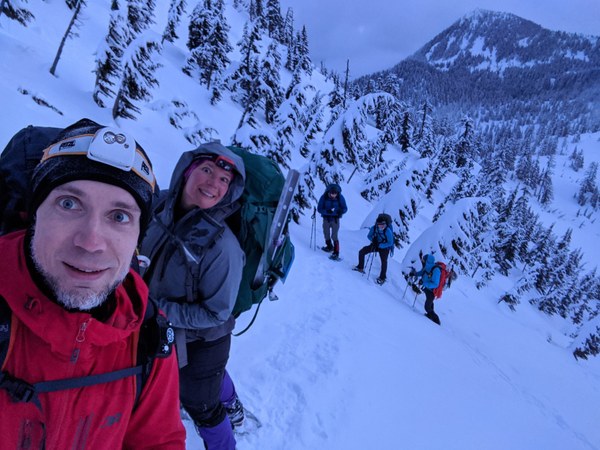
Not long after, Chair Peak popped up in the front in all its glory. Not too shabby! Visibility looked great, too. No fog to get in the way of route-finding or enjoyment. Sweet.
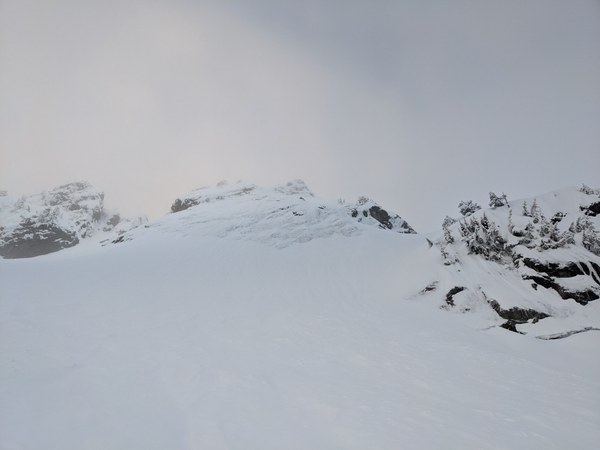
But, we had to earn it yet. The final approach slope was somewhat steep, and required us to break trail, which slowed us down to a crawl.
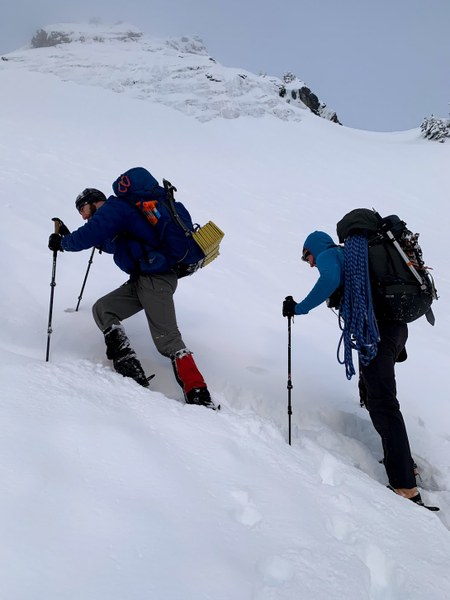
At first, we started seeing headlamps of other parties miles behind us. As we were slowly making our way up an inch at a time, the headlamps started closing in, and eventually popped up right behind us. Danger!
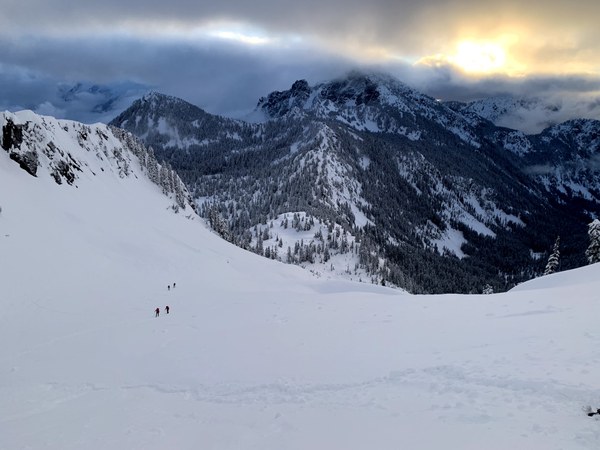
Just about when we were finishing breaking trail, we got beaten to the base of the first pitch by a party of climbers behind us. Ouch! So much for trying to get a head start. The entire approach in total took us about 3 hours.
Below the base of the climb, there's a ridge that extends Southeast, behind which lies a slightly steeper slope. At first, our plan was to get across and setup right below the S-shaped gulley. But, as one of the climbers got closer, he reported hearing a "whoomph", and upon closer look, the ridge showed signs of wind-loading. We decided not to approach, and instead, we opted to pull out our shovels and dig into the steep slope right where we were standing, and so did everyone else.
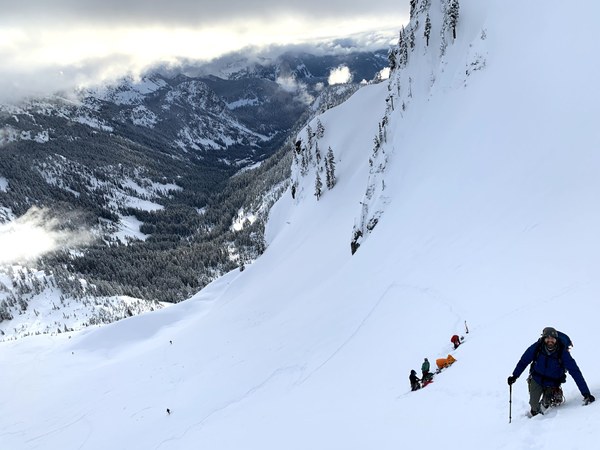
We couldn't see the conditions of the S-shaped gulley. On the other hand, the direct variant of the first pitch was right in the front of us, and it looked like there's some solid alpine ice on the route, so we decided to go with that... and so did everyone else, quickly leading to a small crowd forming at the belay.
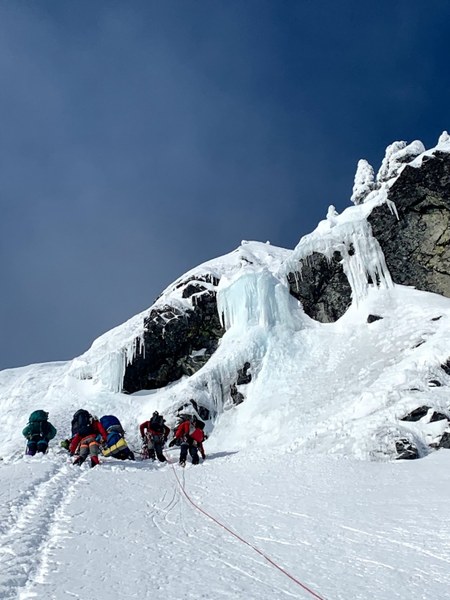
A quick look around, and we saw ants on the snow down below slowly crawling in from all around. They were coming, and they were coming in great numbers. Time was of essence! We needed to get the hell out of there.
One party, disheartened by the look of the crowded belay on the left variation, decided to explore the right side (the S-shaped gulley that constitutes the default option). We saw them struggle with building an anchor for at least an hour as we were standing and waiting for our turn. They made it eventually, but they found that variation hard to protect and not very enjoyable. We will have to get back here to explore this variant another time.
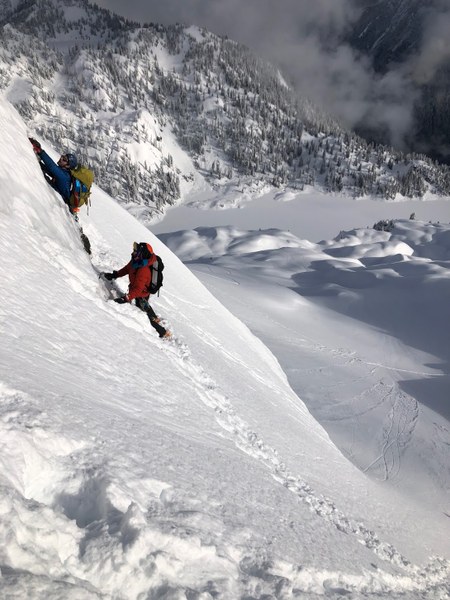
The logistics deserve a comment. We had 5 climbers, so one group of 2 and one group of 3. We had the group of 2 go first. For the group of 3, we did not feel like to carry 2 ropes between the 3 of us, as this would consume energy, and instead opted for the lead climber in our group to take up slack after coming up and have the middle climber to ascend with Microtraxion, then the lead bring the second. The alternative would have been for 2 climbers to tie in and climb together, but since protection on this climb on snow slopes was known to not be very reliable, and falling on ice is a dicey business, I did not feel that would be a safe option.
Microtraxion worked very well for this overall, except for issues with freezing up due to the use of an extension sling that caused it to get dragged on the snow. Pro tip: attach it directly to the belay loop to keep it off the snow.
Eventually, the group ahead of us cleared the belay.
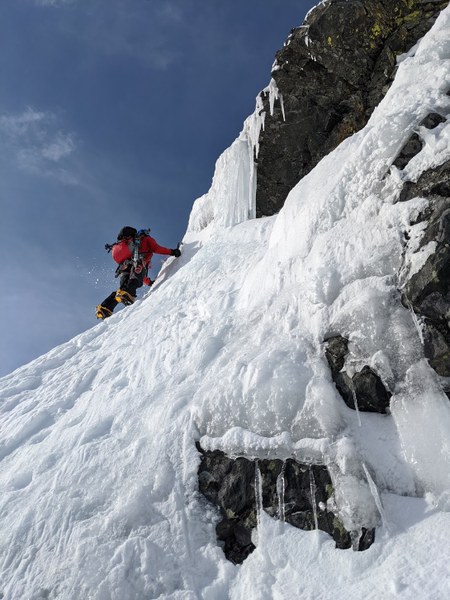
With the belay cleared, we had the chance to inspect the ice up close. Quite good, if a bit thin, with rock lurking from underneath in places. The 22cm screw bottomed-out, but as we were otherwise carrying mostly short screws in the 10-13cm range, there was no problem constructing a bomber belay anchor and placing pro generously along the pitch.
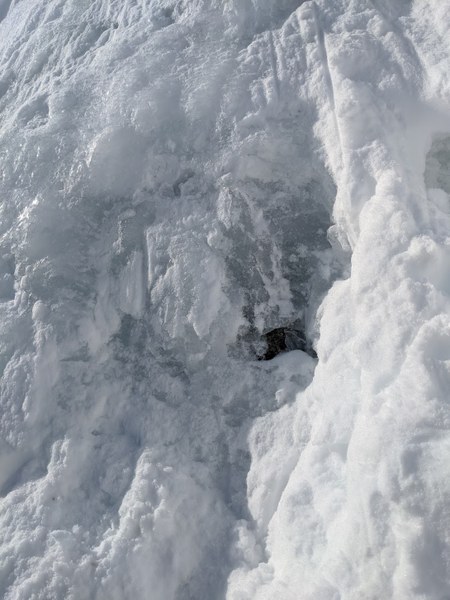
After our group of 2 went up, finally, after about an hour from the approach freezing my butt in the cold, I finally sank the tool into the ice at about 9am. It felt good.
The ice was in the ballpark of AI2, and not very long. After that, it's a bunch of steep snow. Not super protectable, but then, not really needing protection. Looking from the belay down on the slope on the first pitch.
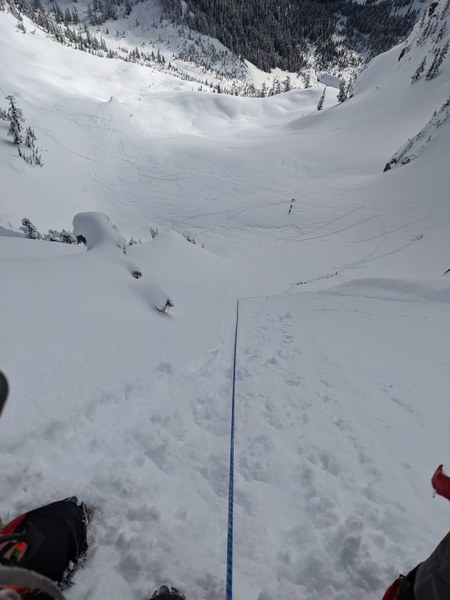
The first pitch ended at a small tree, where our rope teams briefly shared a happy moment, and the only one we got to enjoy together. After that, the team of 2 disappeared on the horizon. They were, unsurprisingly, moving quite a bit faster.
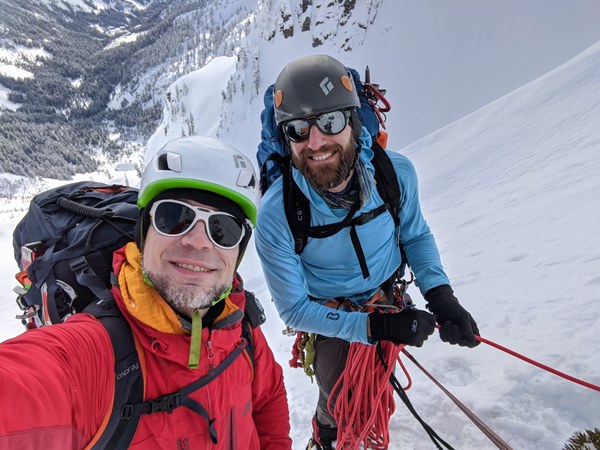
The second and third pitch are all steep snow, protected with pickets along the way. With a 70m rope, we were able to combine the two pitches into one.
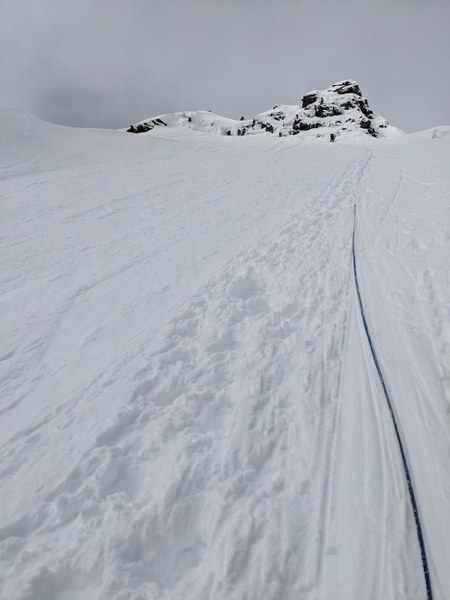
Our group of 2 going first simul-climbed it and built an anchor at the ice step. For our group of 3, simul-climbing with the sketchy pro along the way felt too dicey, so instead we terminated the pitch with at the rock outcropping, perhaps about 40 feet or so from the small ice step. There was good ice there that took screws well.
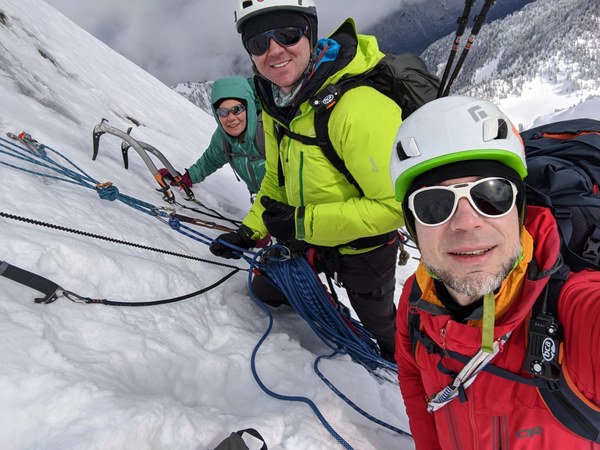
This is pretty much the only place where one could also find some spots for pro in nearby rock. We did carry a small rack of cams (0.3 to 1.0), a set of DMM offset nuts, a Spectre, and a set of Knifeblades, but we never placed any rock pro on this climb.
The fourth (or for us, the third) pitch was the water ice step. Vertical, but only a body length. We climbed it, like everyone else, from the right side.
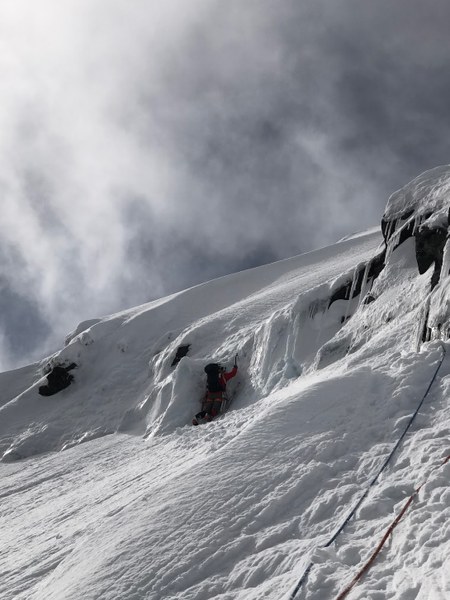
The ice step took a 13cm screw, but right above it, the ice turned out to be too thin to protect the crux even with a stubby. That was a bit disappointing. I managed to find a spot in the snow where a vertical mid-clip picket felt secure, but other than that, the entire pitch was runout, and ended at a random part of a steep slope. Another party following us did the same.
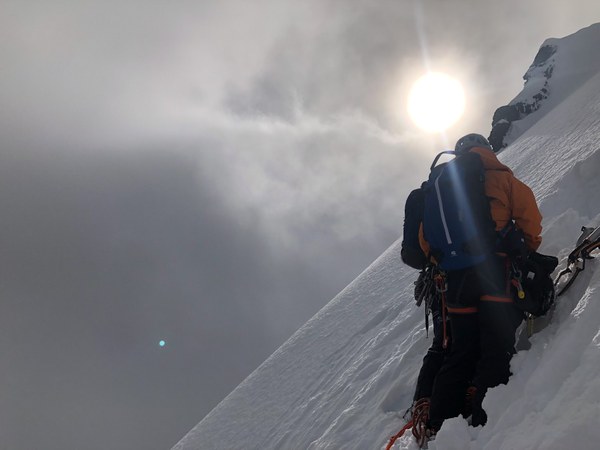
Fortunately, we were carrying our shovels (and all other avy gear), which enabled digging out a generous snow pit and placing a pair of horizontal pickets securely at a legit depth, and even building a little shelf to get the pack off, belay comfortably, and even make a nice spot for the second to rest. Shovels are an absolute must on this one. I am definitely carrying one next time!
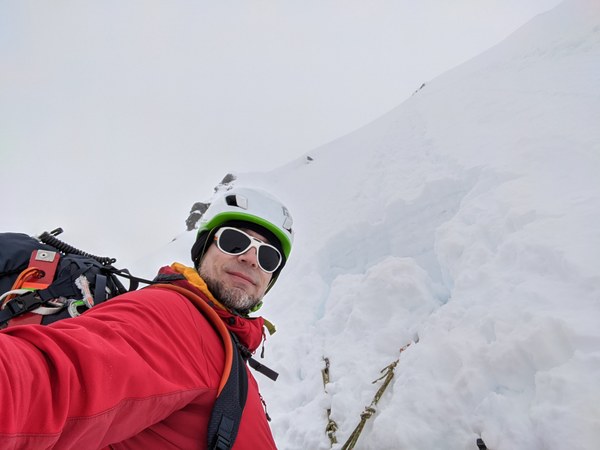
Another benefit of belaying the middle climber with a Microtraxion was the extra time to put on a parka, and finally take the time to eat a sandwitch and hydrate.
Soon after, we were all back together again, excited to soon see the summit:
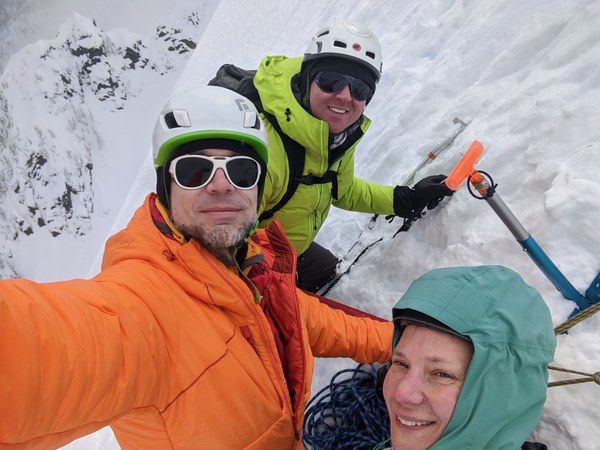
The last pitch (fifth, or in our case fourth) took us to a sub-summit.
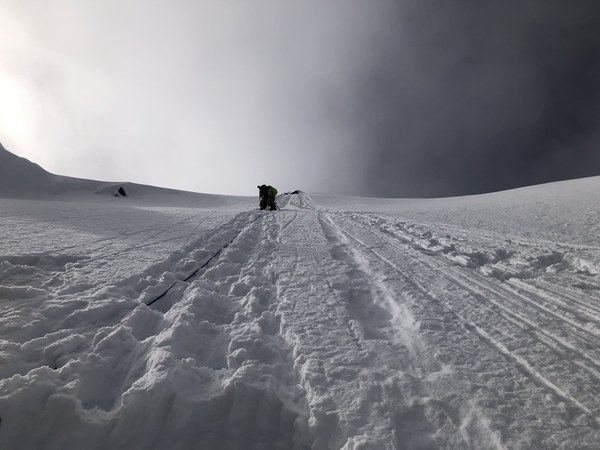
There, we met our fast party of 2 freezing their butts and eager to get on with the rappel. It was 2:30pm. The climbing portion has taken us in total about 5.5 hours, half an hour longer than I had anticipated.
We unroped and did the final summit scramble. Once again, the 3 of us back together :)
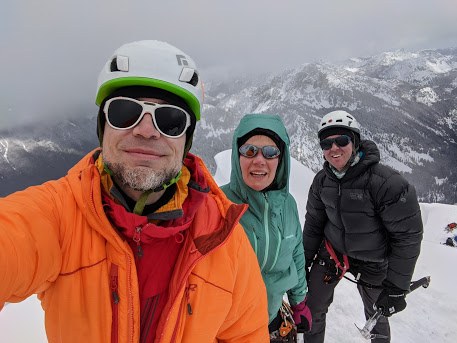
But, our party of 2 were probably freezing... no time to waste, so after a few minutes, we started our scramble back down.
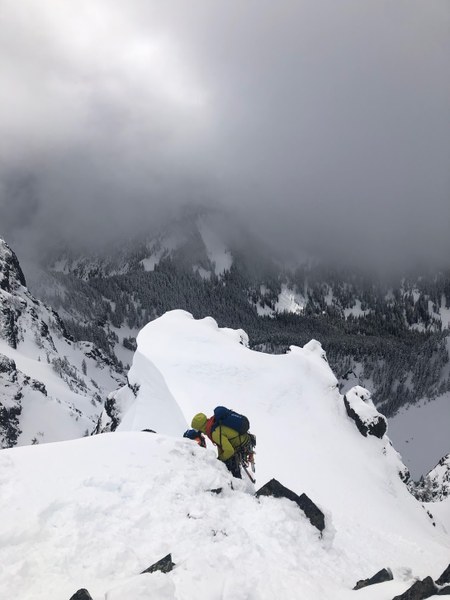
Getting to the rap station was an exposed, but otherwise fairly straightforward scramble. It was not a place to fall, but the snow took tools and frontpoints well.
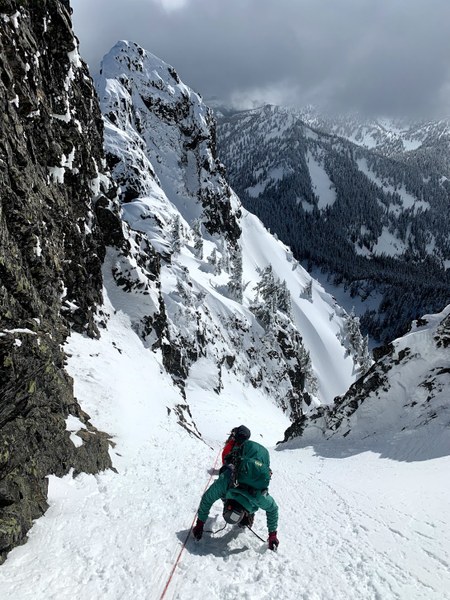
As noted in other repors, the rap station is immediately left, only about 20 feet or so after the rock walls let you out. Looking from the rap station at the down-scramble.
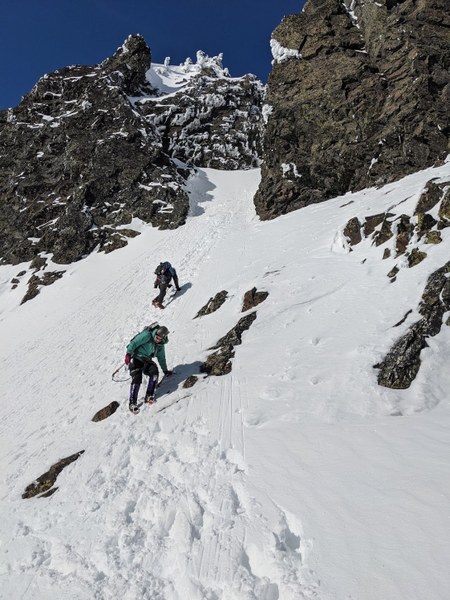
The rap slings in rusty pitons were a few feet above the ground.
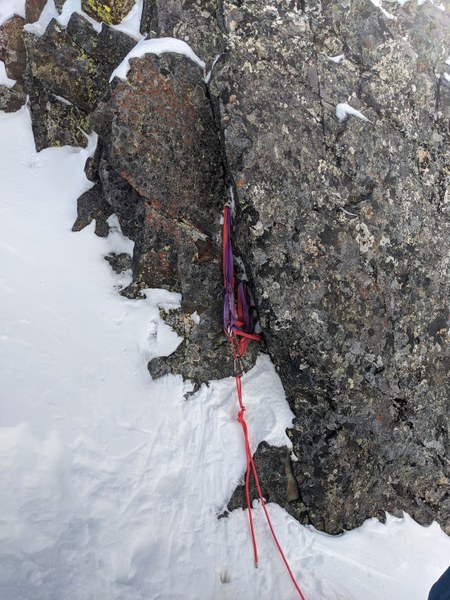
Here we got stuck again behind another party, and lost some time. We started rappelling shortly after 4pm.
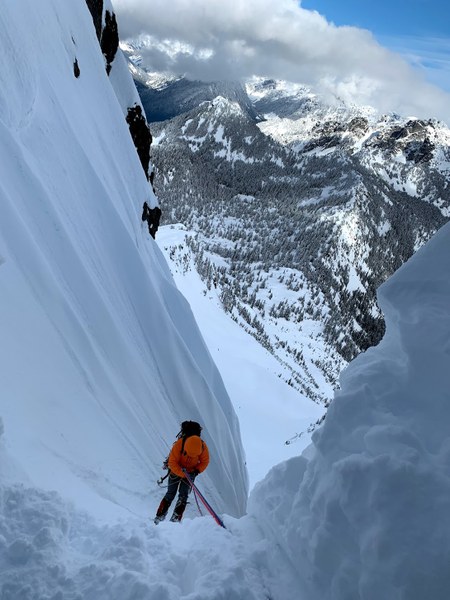
One can see trip reports sometimes mentioning ropes getting stuck on this rappel due to cornice entrenchment. We didn't have a problem with this.
We did hit a minor snafu, in that our radios froze up, and could not communicate on rappel. Not a big deal, but this is the second time my radios froze on me. After a bit of follow-up research, I'm hearing that this isn't an isolated experience.
From the end of the rappel, it's a bit more downclimbing to the gear stash. By then, it was warm and sunny, with mostly clear skies.
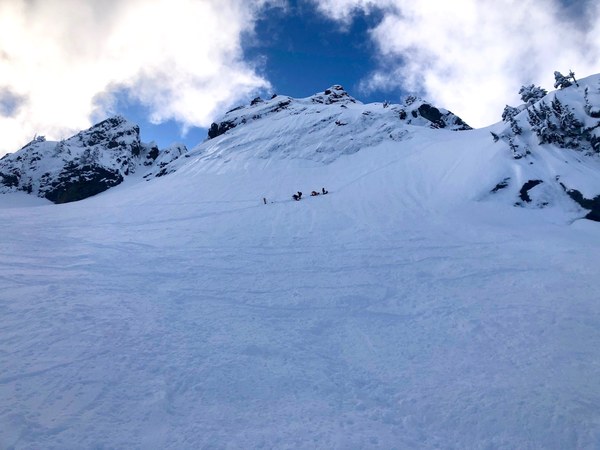
After all the 5 of us rappelled, got down, switched crampons to showshoes, degeared and repacked, we started our descent at around 5pm.
Descending in snowshoes wasn't very pleasant. The snow was pretty hard, in most places not soft enough for plunge stepping, which was hard on the knees and ankles. But, those of us who tried to walk down in boots found themselves post-holing knee-deep.
We made it down in 1:30, and were back to cars 6:30pm, for the total car-to-car time ~13.5 hours. This was half an hour faster than the low end of my 14-16 hour estimate. Whereas I had slightly underestimated the time it would take us to get up, and we got stuck behind other parties on the climb and on the rappel, I also vastly overestimated the time it would take to rappel and descend. All in all, it all went down faster and more smoothly than I anticipated.
The full GPX track: https://www.peakbagger.com/climber/GPXFile.aspx?aid=1347478&sep=1
Overall, this was an amazing, full-value winter experience. We placed a lot of pickets and screws, kicked a lot of steps, and froze our butts at belay stations. Would definitely do it again!
 Krzysztof Ostrowski
Krzysztof Ostrowski